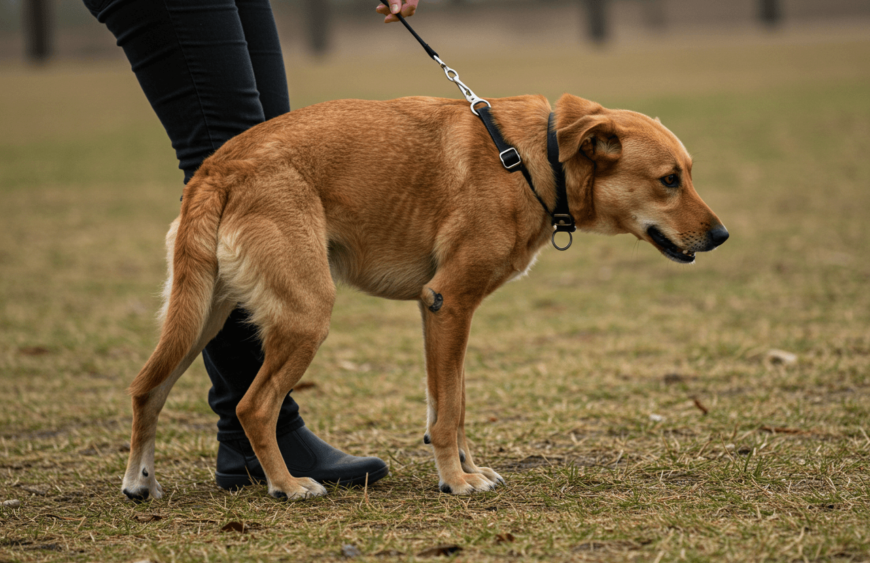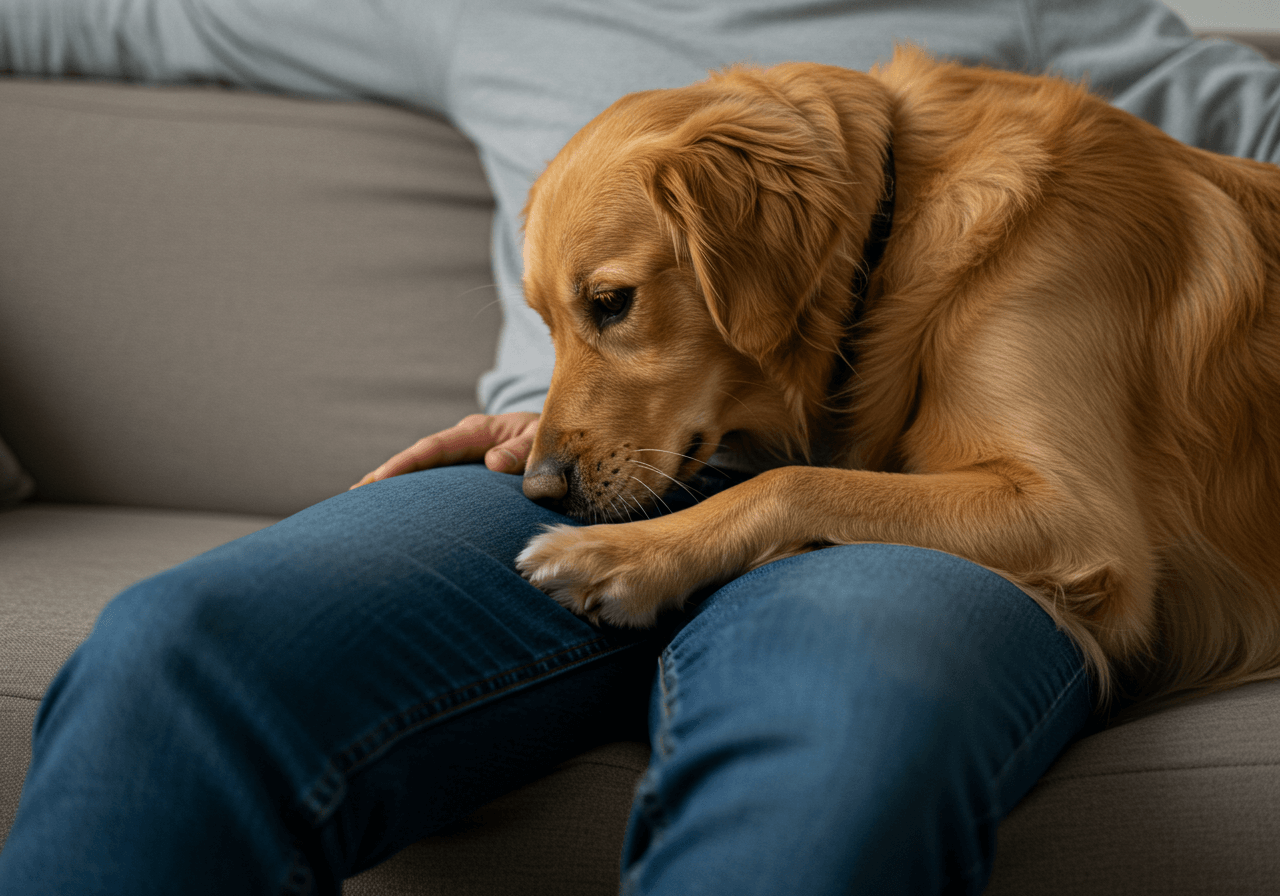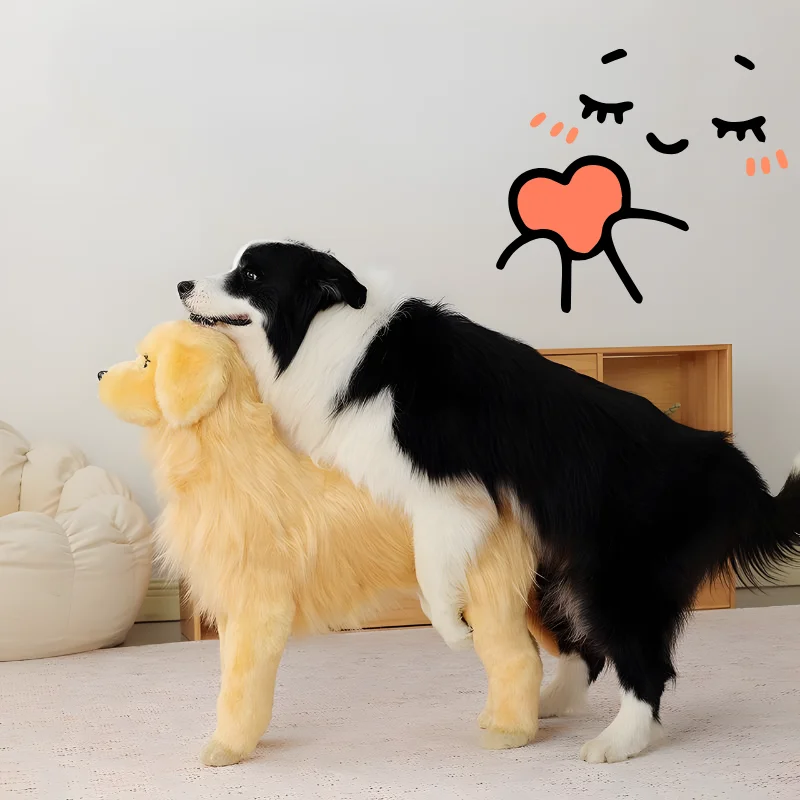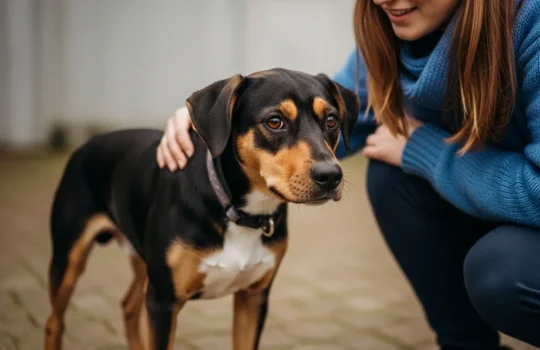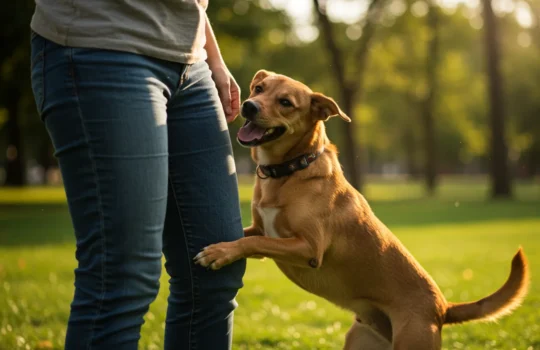不安は多くの雄犬に影響を与え、彼らの幸福と生活の質全体に影響を与えます。人間と同じように、犬も不安を含むさまざまな感情を経験します。不安は特定の状況に対する正常で健康的な反応ですが、飼い主が対処しなければ、過剰な不安は不安障害や行動問題に発展する可能性があります。この記事では、オス犬の不安について、一般的な原因、認識できる症状、効果的な治療法、予防法を取り上げます。私たちは、あなたの毛皮で覆われた友人がより幸せでリラックスした生活を送れるよう、知識とツールを提供することを目的としています。
雄犬の恐怖、恐怖症、不安の定義 🔍 雄犬の恐怖、恐怖症、不安の定義
恐怖、恐怖症、不安の違いを理解することで、オス犬の感情状態を正確に把握し、対処することができます。
恐怖:恐怖は、現実の、あるいは知覚された直接的な脅威に対する本能的な反応です。恐怖は、闘争、逃走、凍結のために身体を準備する適応メカニズムとして機能します。例えば、犬が恐怖を示すのは、うなり声をあげる犬やスピードを出す車に直面したときです。
恐怖症:恐怖症は特定の刺激に対する持続的で過剰な恐怖を伴います。犬はしばしば、実際の脅威に対して不合理で不釣り合いな反応を示します。誘因となる刺激には、掃除機、風船、あるいは特定の物体を見ることなどがあります。その反応はしばしば激しく、衰弱させることもあります。関連した出来事や記憶が恐怖症的反応を引き起こすこともあります。
不安:不安は、未知の、あるいは想像上の将来の危険を予期するもの。より一般化された不安状態を作り出し、恐怖に似た身体的反応として現れますが、はっきりと定義された直接的な誘因はありません。オスの犬は、歩いたり、パンティングしたり、落ち着きがなくなったりして、不安を示すかもしれません。分離不安は、ひとりぼっちにされたときの苦痛によって特徴づけられる特定のタイプの不安です。これはしばしば破壊行動や発声につながります。
オス犬の不安の原因
オス犬の不安にはいくつかの要因があります。根本的な原因を特定することは、効果的な治療計画を立てるために不可欠です。
➤ 恐怖に関連した不安の引き金
恐怖に関連する不安は、一般的に特定の刺激から生じます。一般的な誘因には、大きな音(花火、雷)、見慣れない他人、強烈な視覚刺激(点滅する光)、新しく圧倒される環境、特定の状況(獣医の診察、車の乗車)などがあります。
分離不安の理解
分離不安は、犬が一人にされたときに安らぎや安心感を得られないときに起こります。その結果、室内での排尿や排便、破壊的な噛み癖、過剰な吠え声などの好ましくない行動を引き起こすことがあります。日常生活の変化、新しい家への引っ越し、家族(人間または動物)の喪失など、多くの要因が分離不安の引き金となります。
シニア犬の加齢に伴う不安 ➤ シニア犬の加齢に伴う不安
認知機能障害症候群(CDS)は、しばしば犬の認知症と呼ばれ、一般的にシニア犬に不安を引き起こします。CDSは、混乱、見当識障害、記憶や意識の低下を引き起こし、不安や恐怖を増大させます。
その他の不安要因
- トラウマ体験:虐待やネグレクト(育児放棄)などの過去のトラウマは、心に永続的な傷を残し、不安を助長します。
- 社会化の欠如:子犬期の社会化が不十分だと、犬は新しい人や場所、状況に対して恐怖心を抱くようになります。
- 遺伝学:不安の素因を受け継ぐ犬もいます。
- 基礎疾患:不安のような症状が、甲状腺の問題や痛みなどの基礎疾患から生じていることもあります。
🚨 オス犬の不安症状の認識
不安症状を特定することで、早期介入が可能になります。これらの症状はさまざまな形で現れます:
- 攻撃性:不安は時に攻撃性として現れ、恐怖の原因に向けられたり、他の人や動物に向けられたりします。
- 不適切な排除:しつけができているにもかかわらず、家の中で排尿や排便をするのは、不安の表れです。
- 過度のよだれ:唾液分泌の増加は、ストレスに対する生理的反応として一般的に起こります。
- 息切れ:体を動かしていないときや暑くないときでも、息を切らすのは不安のシグナルです。
- 破壊的行動:ドアや家具を噛んだり、掘ったり、ひっかいたりするのは、不安、特に分離不安であることがよくあります。
- うつ病:内向的な態度、食欲の低下、活動への興味の欠如はうつ病を示唆し、慢性的な不安としばしば結びつきます。
- 過剰な吠え声/遠吠え:長時間の執拗な発声は、苦痛や不安を表します。
- ペーシング:落ち着きなく行ったり来たりするのは、一般的に不安の表れです。
- 落ち着きのなさ:たとえ慣れ親しんだ環境であっても、落ち着くことができない、リラックスできないということは、不安を示唆しています。
- 反復的または強迫的な行動:前足をなめる、尻尾を追いかける、またはその他の反復行動は、不安の対処メカニズムとして機能します。
- 去勢後の行動: 切開部位を過度に舐めたり、歩き回ったり、繰り返し鳴いたりするなどの行動が、対処メカニズムとして現れることがあります。 去勢後の不安。これらの行動は、手術後の不快感、ホルモンの変化、環境の変化に対処しようとする犬の行動を反映していることが多いです。
ᔬ オス犬の不安症の診断
適切な診断により、適切な処置が決定されます。
- 獣医学的検査:まず、獣医師に相談してください。健康診断を行い、症状の原因となる基礎疾患を除外するための検査を行います。
- 治療計画:獣医師は、投薬と行動修正訓練を処方します。
オス犬の不安に対する💊治療法
オス犬の不安症の治療には、個々の犬のニーズに合わせた多面的なアプローチが必要です。
➤ 専門家への相談
まず獣医師と相談し、不安の種類を正確に特定し、潜在的な根本原因を探り、具体的な誘因を突き止めることから始めます。トレーニング、予防戦略、そして必要であれば薬物療法を統合した包括的な治療計画を一緒に立てましょう。
➤ トレーニングとカウンターコンディショニング
カウンターコンディショニング犬の反応を変える カウンターコンディショニングは、不安を引き起こす刺激に対する犬の反応を変化させます。目標は、不安な行動を、お座りする、飼い主に注目する、芸をする、などのより望ましい行動に置き換えることです。トリガーとなる刺激に、おいしいおやつなどポジティブなものを組み合わせることで、これを達成します。
脱感作:トリガーを徐々に導入 減感作では、犬の不安の原因となっているものを、少量ずつ、強さを弱めながら徐々に紹介していきます。時間をかけて徐々に恐怖反応を減らしていくことが目的です。
プロフェッショナル・トレーニング・サポート 不安管理の経験を持つプロのドッグトレーナーは、これらのテクニックを効果的に実行するための指導とサポートを提供します。
➤ 犬の不安治療薬
SSRIと抗うつ薬 フルオキセチン(プロザック)やクロミプラミン(クロミカーム)などの選択的セロトニン再取り込み阻害薬(SSRI)や三環系抗うつ薬(TCA)は、脳内化学反応を調整し、不安を軽減します。
ベンゾジアゼピン アルプラゾラム(ザナックス)などのベンゾジアゼピン系抗不安薬は、雷雨や花火、車での移動など、予測可能な出来事によく効きます。
セレギリン セレギリン(アニプリル)は、シニア犬の認知機能障害症候群(CDS)に伴う不安を管理します。
自然療法 アダプティルのディフューザーや首輪などのフェロモン製品は、気持ちを落ち着かせる効果があります。ラベンダーのような鎮静効果のあるエッセンシャルオイルを使ったアロマセラピーも、不安な犬には効果的です。
➤ 犬の不安のためのCBDオイル
逸話的報告 多くの犬の飼い主が、愛犬の不安を管理するためにCBDオイルを使用したところ、良い結果が得られたと報告しています。
科学的考察 犬の不安に対するCBDの有効性に関する科学的データはまだ限られています。CBD製品には規制がないため、潜在的な効果、リスク、可能性のある副作用について獣医師に相談してください。
進行中の研究 AKC犬健康財団は現在、てんかんの犬に対するCBDの使用に関する研究に資金を提供しています。この研究によって、不安を含む他の症状に対するCBDの潜在的な利益とリスクに関するさらなる洞察が得られるかもしれません。
➤ 不安を和らげるおもちゃ
適切なおもちゃは、犬のエネルギー発散や不安解消に役立ちます。愛犬のサイズに合ったものを選びましょう。
大型犬のセックスのおもちゃに直接移動するには、リンクをクリックしてください。->
小型犬・中型犬のセックスのおもちゃに直接行くには、リンクをクリックしてください。->
🛡️ オス犬の不安を防ぐ
予防は治療よりも効果的です。これらの戦略を実行することで、犬が不安になる可能性を減らすことができます。
➤ 犬のコミュニケーションの理解
犬のボディ・ランゲージを読むことを学びましょう。不快感や恐怖のサインをいち早く察知することで、ストレスの多い状況から愛犬を遠ざけたり、安心させてあげることができます。
➤ 適切な社会化
愛犬の重要な社会化期(およそ生後3~16週間)に、さまざまな人、犬、他の動物、場所、経験に触れさせましょう。そうすることで、犬は順応し、自信を持てるようになります。
➤ 効果的な服従訓練
服従訓練は、信頼とコミュニケーションの上に成り立つ健全な関係を築きます。また、愛犬に不安な状況をコントロールする感覚を与えます。
➤ 心身の健康
定期的な身体的・精神的刺激は全身の健康を促進します。脳の健康をサポートし、不安を軽減するために、質の高い食事と組み合わせましょう。
➤ トリガー露出の管理
可能な限り、愛犬が既知の誘因に接触する機会を減らしましょう。ただし、こうした状況を完全に避けてはいけません。むしろ、ポジティブなトレーニングの機会として利用しましょう。
🌎 不安定な犬のために安全な空間を作ること
安全な空間は、愛犬がリラックスして守られていると感じられる、安全で快適な隠れ家です。
- 静かでプライベートな隠れ家:愛犬がストレスの多い状況から逃れられるよう、落ち着いた静かなプライベート空間を確保しましょう。
- 家具調密閉木箱:多くの犬が心地よいと感じる巣穴のような雰囲気を提供します。
- 屋根付き "洞窟 "ベッド:これらのベッドは、安全性と閉鎖性を提供します。
- 犬用テントベッド:洞窟のベッドに似たこのテントは、安全で居心地の良い空間を提供します。
👨⚕️ いつ専門家の助けを求めるべきか
専門家に助けを求めるタイミングを見極めることが重要です。
- 効果のない家庭療法:家庭でできる治療法で改善しない場合は、専門家に相談してください。
- 重症または突然の発症:不安がひどい場合や突然発症した場合は、ただちに専門家に相談してください。
- 健康上の懸念:獣医師は、基礎疾患を除外することができます。
- 高度な治療オプション:動物行動専門医は、専門的な行動修正テクニックと薬物療法の選択肢を提供します。
⚠️ 不安がる犬にやってはいけないこと
ある行動が犬の不安を悪化させます。
- 罰を避ける:不安のサインを見せたからといって犬を罰しても、より恐怖や不安を募らせるだけです。
- 落ち着いて:犬はあなたの怒りを察知し、不安と結びつけて状況を悪化させます。
結論:オス犬の不安管理
不安は多くの犬に影響を及ぼし、その原因、症状、治療法を理解することは犬の幸福を向上させます。トレーニング、環境の改善、そして必要な場合には薬物療法を含む多面的なアプローチによって、不安は効果的に管理されます。診断、治療計画、および基礎的な健康問題の除外のために、常に獣医師に相談してください。

